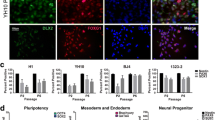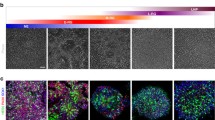Abstract
Neural differentiation of human embryonic (ES) and induced pluripotent (iPS) stem cell lines has been used for research in early human development, drug discovery, and cell replacement therapies. It is critical to establish generic differentiation protocols to compare the neural specification potential of each individually derived pluripotent stem cell line and identify the efficacious lines for research and therapeutic use. Here, we describe a reproducible and quantitative protocol to assess the neural progenitor (NP) generation of human pluripotent stem cell lines. This method includes a robust and well-defined neural inducing platform for Pax6+ neural rosette (neuroectodermal cells) generation, propagation, and subsequent differentiation into nestin+ NPs. A side-by-side comparison under common culture conditions among three human ES cell lines, TE03, TE06, and BG01V, and one iPS cell line, HD02, showed highly variable efficiency in their differentiation into NPs.
Access this chapter
Tax calculation will be finalised at checkout
Purchases are for personal use only
Similar content being viewed by others
References
Li XJ, Du ZW, Zarnowska ED, Pankratz M, Hansen LO, Pearce RA, Zhang SC (2005) Specification of motoneurons from human embryonic stem cells. Nat Biotechnol 23:215–221
Zhang SC (2006) Neural subtype specification from embryonic stem cells. Brain Pathol 16:132–142
Li XJ, Zhang SC (2006) In vitro differentiation of neural precursors from human embryonic stem cells. Methods Mol Biol 33:169–177
Ma W, Tavakoli T, Derby E, Serebryakova Y, Rao MS, Mattson MP (2008) Cell-extracellular matrix interactions regulate neural differentiation of human embryonic stem cells. BMC Dev Biol 8:90
Hu BY, Weick JP, Yu J, Ma LX, Zhang XQ, Thomson JA, Zhang SC (2010) Neural differentiation of human induced pluripotent stem cells follows developmental principles but with variable potency. Proc Natl Acad Sci USA 107:4335–4340
Hu BY, Du ZW, Zhang SC (2009) Differentiation of human oligodendrocytes from pluripotent stem cells. Nat Protoc 4:1614–1622
Hu BY, Zhang SC (2009) Differentiation of spinal motor neurons from pluripotent human stem cells. Nat Protoc 4:1295–1304
Zhang XQ, Zhang SC (2010) Differentiation of neural precursors and dopaminergic neurons from human embryonic stem cells. Methods Mol Biol 584:355–366
Swistowski A, Peng J, Liu Q, Mali P, Rao MS, Cheng L, Zeng X (2010) Efficient generation of functional dopaminergic neurons from human induced pluripotent stem cells under defined conditions. Stem Cells 28:1893–1904
Zeng H, Guo M, Martins-Taylor K, Wang X, Zhang Z, Park JW, Zhan S, Kronenberg MS, Lichtler A, Liu HX, Chen FP, Yue L, Li XJ, Xu RH (2010) Specification of region-specific neurons including forebrain glutamatergic neurons from human induced pluripotent stem cells. PLoS One 5:e11853
Tavakoli T, Derby E, Serebryakova Y, Rao MS, Mattson MP, Ma W (2009) Self-renewal and differentiation capabilities are variable between human embryonic stem cell lines I3, I6 and BG01V. BMC Cell Biol 10:44
Huan Q, Gao X, Wang Y, Shen Y, Ma W, Chen ZJ (2010) Comparative evaluation of human embryonic stem cell lines derived from zygotes with normal and abnormal pronuclei. Dev Dyn 239:425–438
Gao X, Yan J, Shen Y, Li M, Ma S, Wang J, Huan Q, Huang S, Ma W, Chen ZJ (2010) Human fetal trophonema matrix and uterine endometrium support better human embryonic stem cell growth and neural differentiation than mouse embryonic fibroblasts. Cell Reprogram 12:295–303
Amit M, Itskovitz-Eldor J (2002) Derivation and spontaneous differentiation of human embryonic stem cells. J Anat 200(Pt 3):225–232
Zeng X, Miura T, Luo Y, Bhattacharya B, Condie B, Chen J, Ginis I, Lyons I, Mejido J, Puri RK, Rao MS, Freed WJ (2004) Properties of pluripotent human embryonic stem cells BG01 and BG02. Stem Cells 22:292–312
Zeng X, Chen J, Liu Y, Luo Y, Schulz TC, Robins AJ, Rao MS, Freed WJ (2004) BG01V: a variant human embryonic stem cell line which exhibits rapid growth after passaging and reliable dopaminergic differentiation. Restor Neurol Neurosci 22:421–428
Acknowledgment
The authors wish to thank Yevgeniya Serebryakova and Eric Derby for their technical supports.
Author information
Authors and Affiliations
Corresponding author
Editor information
Editors and Affiliations
Rights and permissions
Copyright information
© 2012 Springer Science+Business Media, LLC
About this protocol
Cite this protocol
Yin, D., Tavakoli, T., Gao, WQ., Ma, W. (2012). Comparison of Neural Differentiation Potential of Human Pluripotent Stem Cell Lines Using a Quantitative Neural Differentiation Protocol. In: Turksen, K. (eds) Human Embryonic Stem Cells Handbook. Methods in Molecular Biology, vol 873. Humana Press, Totowa, NJ. https://doi.org/10.1007/978-1-61779-794-1_16
Download citation
DOI: https://doi.org/10.1007/978-1-61779-794-1_16
Published:
Publisher Name: Humana Press, Totowa, NJ
Print ISBN: 978-1-61779-793-4
Online ISBN: 978-1-61779-794-1
eBook Packages: Springer Protocols




